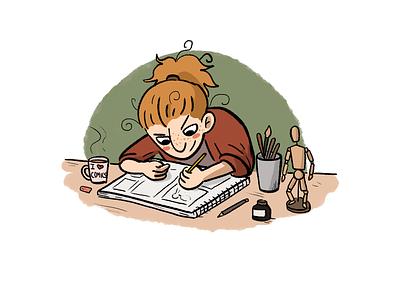Looking for all Articles by Georgia McLellan?
Five steps to creating a graphic novel
Former What's Your Story? participant, comic artist and full-time animation student Georgia McLellan shares her top tips for creating a graphic novel.

Creating a graphic novel can seem like a daunting task. It's easy to forget that the glossy publications on the bookstore shelves started off as a rough idea and a few messy thumbnails. But don't despair! If you give yourself time, follow through with your project and have fun, you'll be surprised at the incredible things you can create.
Here are five simple steps to help you get started.
Writing
Many people think that graphic novels are only about the art and sometimes they are. However, for most stories, the art and the writing work hand in hand. The words don't need to be complex – but it's important to give them thought.
Always make sure the words you put on the page are intentional and serve a purpose. A more concise sentence paired with a strong image is far more powerful than paragraphs of text. Remember, what the words don't say – the drawings will.
Layout and Pacing
Graphic novels are different from other published media in that the story flows across the page like a film. Your panels have the incredible power to determine the pace that the reader will observe the scene. If you want to slow it down, consider padding it out with drawings of the background surroundings. If you want to speed it up, consider using jagged, dynamic panels which will cut quickly between the main actions.
No matter what layout you use, it's important to remember that the reader sees the graphic novel as a double page spread. Make sure both pages work well together so that the story flows smoothy.
Drawing and Inking
The next step is the fun one! Starting to draw! Your art style doesn't have to be pristine and perfect. You don't have to have a fine art degree under your belt to draw an effective comic. Some of the best graphic novels have the simplest drawings. It can be done entirely digitally, completely hand-drawn with traditional media or a mix of both.
No matter what your chosen art style, always make sure you leave plenty of space for lettering. Remember your comic is both art AND writing. The writing deserves as much space and respect on the page as the art does.
Colouring
Colouring is much more than making your art look pretty. It's about setting the scene and describing the emotions or actions within. If the scene is dynamic and exciting, the use of bright and vibrant colours can really heighten the atmosphere.
Sometimes, the extreme, such as making an entire sad scene in shades of blue or doing the whole thing in black and white can be very emotionally powerful so don't be afraid to push your colours.
Lettering
The final step is to add your lettering. This can be hand-drawn or added via a computer. Choose a font which fits the story and remember to keep your speech balloons wide enough so that the reader can take in the words properly.
Have Fun!
Remember there's no one way to create a comic. Some artists find that they draw the entire thing and then write the script afterwards. Others can't even pick up a pencil before they've typed out every line to perfection. It's your unique story, and you can tell it in whatever way you like.
The important thing is to get started!